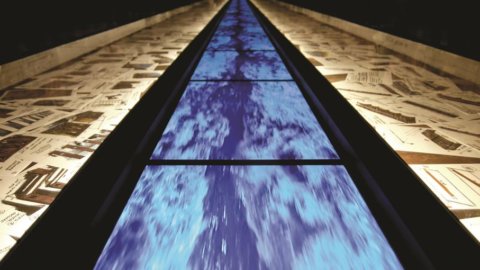Precisely water is one of the most characteristic figures in the artist's work. An element that, since 1968, has guided many of his creations, be they installations, films, videotapes and performances. As Plessi himself recalled, “water has always been the dominant motif of my life and my artistic and cultural itinerary”.
PLESSI IN VENICE consists of two distinct moments, both curated by Marco Tonelli.
The first is the PLESSI exhibition. LIQUID LIFE. The flow of memory. 1000 projects, organized by the Polo Museale del Veneto in collaboration with the Alberto Peruzzo Foundation, under the patronage of EXPO 2015 and the Italian Pavilion EXPO 2015, scheduled from 6 May to 22 November 2015 to the Giorgio Franchetti Gallery at the Ca' d'Oro, a very suggestive building rich in history, which overlooks the Grand Canal of Venice.
At the Ca' d'Oro Plessi has thought of a video installation in which screens, inserted inside tables, will send back images of an "electronic flow" of water, to ideally represent the flow of thoughts and of his entire creative life.
The works will be able to trigger highly evocative pictorial visions. “I think that video – says the artist – forms a perfect combination with water: water is an iridescent, ancient, primordial ancestral element, video is a contemporary element: both are fluid, unstable. Both give off a blue glow.” The same glow that Plessi was able to encounter in the inventions of Tintoretto and Titian, and that he was able to study and appreciate while living in a city of water like Venice. Tables as sculptures but also containers of a thousand drawings that represent the ideational and planning nucleus of his works.
"If light, pure electricity - says the curator, Marco Tonelli - is the primordial material that animates technology, drawing is in Plessi memory, personal experience and imagination that gives strength to another type of energy, the inner one of the artist himself, capable of capturing the vibrations of a modernity that a great sociologist of our time like Zygmunt Bauman has defined liquid”.
The other event, organized by the Alberto Peruzzo Foundation, with the patronage of the Veneto Regional Council and VENICE TO EXPO 2015, will propose on the same dates at Tesa 94 in the Arsenale, a single large installation, entitled PLESSI. LIQUID LIGHT, which for the first time in forty years now does not bear any trace of monitors or plasma screens, but only a soft and mysterious blue light (reminiscent of the light of the television), which emerges from the keels of fourteen boats upside down, the llaüt, traditional boats of the Balearic Islands for trawling and the sound of the waves of the sea.
Following the intervention of the European Community which encouraged their disposal, many llaüt were abandoned by the fishermen. Fabrizio Plessi, after a phase of meticulous research and recovery in Mallorca, wanted to give them new life by making them the content and container of this installation that pays homage to the Mediterranean.
The PLESSI IN VENICE project is accompanied by two Peruzzo Editoriale catalogues: one specifically dedicated to the Ca' d'Oro exhibition, another to the Arsenale installation.
Fabrizio Plessi. Biographical notes
Fabrizio Plessi (Reggio Emilia, 1940), completed his studies at the Academy of Fine Arts in Venice, where he then taught for many years. Using video as an artistic tool, he has traced an innovative path that has made him famous all over the world. Co-founder of the Kunsthochschule für Medien in Köln, he taught Humanization of Technologies and Electronic Scenography. His Bombay-Bombay installation is famous at the Ludwig Museum in Köln. He participates in 14 editions of the Venice Biennale from 1970 until the last one in 2011 with Mari Verticali at the Venice Pavilion. In Italy he was awarded by the Quadriennale of Rome in 1999. In the same year the Kestner Gesellschaft of Hannover awarded him as artist of the year with the NLB award. In 2002 anthological Paradiso/Inferno at the Scuderie del Quirinale in Rome. He has had over 500 solo exhibitions, from the Center Pompidou in Paris (1982) to the Guggenheim in New York (1998), from the Museum of Contemporary Art in San Diego (1998) to the Guggenheim in Bilbao (2001). He participates in Documenta VIII in Kassel (1987) with the famous installation Rome. He was present in Berlin in 2003 with an anthology at the Martin Gropius Bau. Also in Berlin he creates a large installation for the Sony Center in Potzsdammer Platz. He collaborates with the most important museums in Austria such as the Kunshistoriche Museum, the Museum Ludwig and the Neue Galerie in Linz. Even emerging countries have a sure point of reference in Plessi, as evidenced by the inauguration of the new Museum of Contemporary Art in Rabat in 2006. he Participates in the Cairo Biennale as an artist of honor in 2001; as well as that of Sharjah, Saõ Paulo and Gwangju in Korea in 2000. Since 2008 he has collaborated with the Louis Vuitton group, combining his art with the events of the famous French house, such as the America's Cup for example. the industry as evidenced by its links with BMW, Dornbracht, Loewe, Swarovski, Calvin Klein. Intellectuals and musicians such as Robert Wilson, Philip Glass and Michael Nyman worked with him. The electronic scenography he created for the Luciano Pavarotti concert in New York's Central Park in 1993 is unforgettable. Monumenta in Agrigento is his last grandiose installation created inside the Valley of the Temples. On 21 June 2013 the Plessi Museum opens at the Brenner Pass, which houses a permanent exhibition venue dedicated to his art and is the first Italian example of a museum space on the motorway. In 2014 he was awarded the Pino Pascali Prize: the Museum and the Foundation which in Polignano a Mare commemorate the great Apulian artist dedicate a personal exhibition to him.
PLEXES. LIQUID LIFE
The flow of memory. 1000 projects
6 May – 22 November 2015





